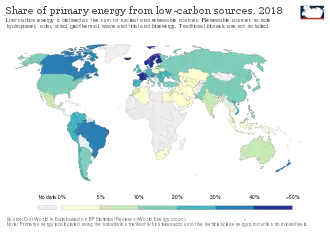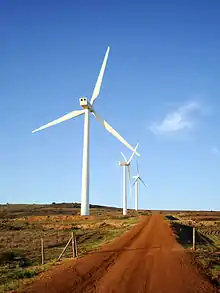A low-carbon economy (LCE) or decarbonised economy is a concept for a desirable economy which has relatively low greenhouse gas (GHG) emissions per person. GHG emissions due to human activity are the dominant cause of observed climate change since the mid-20th century.[2] There are many strategies and approaches for moving to a low-carbon economy, such as encouraging renewable energy transition, efficient energy use, energy conservation, electrification of transportation (e.g. electric vehicles), carbon capture and storage, climate-smart agriculture. An even more ambitious target than low-carbon economies are zero-carbon economies with net zero emissions. An example are zero-carbon cities.
Shifting from high-carbon economies to low-carbon economies on a global scale could bring substantial benefits for all countries.[3] It would also contribute to climate change mitigation.
Definition and terminology
There are many synonyms or similar terms in use for low-carbon economy which stress different aspects of the concept, for example: green economy, sustainable economy, carbon-neutral economy, low-emissions economy, climate-friendly economy, decarbonised economy.
The term carbon in low-carbon economy is short hand for all greenhouse gases.
The UK Office for National Statistics published the following definition in 2017: "The low carbon economy is defined as economic activities that deliver goods and services that generate significantly lower emissions of greenhouse gases; predominantly carbon dioxide."[4]: 2
Rationale and aims

| Part of a series on |
| Climate change mitigation |
|---|
GHG emissions due to human activity are the dominant cause of observed climate change since the mid-20th century.[2] Continued emission of greenhouse gases will cause long-lasting changes around the world, increasing the likelihood of severe, pervasive, and irreversible effects for people and ecosystems.[2]
Nations may seek to become low-carbon or decarbonised economies as a part of a national climate change mitigation strategy. A comprehensive strategy to mitigate climate change is through carbon neutrality.[5]
Methods
Achieving a low-carbon economy involves reducing greenhouse gas emissions in all sectors that produce greenhouse gases, for example energy, transportation, industry, and agriculture. The literature often speaks of a transition from a high-carbon economy to a low-carbon economy. This transition should take place in a just manner (this is termed just transition).[6]: 75
There are many strategies and approaches for moving to a low-carbon economy, such as encouraging renewable energy transition, efficient energy use, energy conservation, electrification of transportation (e.g. electric vehicles), carbon capture and storage, climate-smart agriculture. This requires for example suitable energy policies, financial incentives (e.g. emissions trading, carbon tax), individual action on climate change, business action on climate change.
Actions taken by countries
.jpg.webp)
On the international scene, the most prominent early step in the direction of a low-carbon economy was the signing of the Kyoto Protocol, which came into force in 2005, under which most industrialized countries committed to reduce their carbon emissions.[7][8]
OECD countries could learn from each other and follow the examples of these countries in these sectors: Switzerland for their energy sector, UK for their industry, Netherlands for their transport sector, South Korea for their agriculture, and Sweden for their building sector.[9]
Co-benefits

The main benefit of a transition to low-carbon economies is that it would contribute towards climate change mitigation. Apart from that, other co-benefits can also be identified: Low-carbon economies present multiple benefits to ecosystem resilience[10], trade, employment, health, energy security, and industrial competitiveness.[11][12]
During the green transition, workers in carbon-intensive industries are more likely to lose their jobs. The transition to a carbon-neutral economy will put more jobs at danger in regions with higher percentages of employment in carbon-intensive industries.[13][14][15] Employment opportunities by the green transition are associated with the use of renewable energy sources or building activity for infrastructure improvements and renovations.[16]
Low emission industrial development and resource efficiency can offer many opportunities to increase the competitiveness of economies and companies. According to the Low Emission Development Strategies Global Partnership (LEDS GP), there is often a clear business case for switching to lower emission technologies, with payback periods ranging largely from 0.5–5 years, leveraging financial investment.[17]
Energy aspects
Low-carbon electricity

Low-carbon electricity or low-carbon power is electricity produced with substantially lower greenhouse gas emissions over the entire lifecycle than power generation using fossil fuels. The energy transition to low-carbon power is one of the most important actions required to limit climate change.[18]
Low carbon power generation sources include wind power, solar power, nuclear power and most hydropower.[19][20] The term largely excludes conventional fossil fuel plant sources, and is only used to describe a particular subset of operating fossil fuel power systems, specifically, those that are successfully coupled with a flue gas carbon capture and storage (CCS) system.[21] Globally almost 40% of electricity generation came from low-carbon sources in 2020: about 10% being nuclear power, almost 10% wind and solar, and around 20% hydropower and other renewables.[18]Nuclear power
As of 2021, the expansion of nuclear energy as a method of achieving a low-carbon economy has varying degrees of support.[22] Agencies and organizations that believe decarbonization is not possible without some nuclear power expansion include the United Nations Economic Commission for Europe,[23] the International Energy Agency (IEA),[24] the International Atomic Energy Agency,[25] and the Energy Impact Center (EIC).[26] Both IEA and EIC believe that widespread decarbonization must occur by 2040 in order mitigate the adverse effects of climate change and that nuclear power must play a role. The latter organization suggests that net-negative carbon emissions are possible using nuclear power to fuel carbon capture technology.[26][27]
| Part of a series about |
| Environmental economics |
|---|
 |
Energy transition

An energy transition (or energy system transformation) is a significant structural change in an energy system regarding supply and consumption. Currently, a transition to sustainable energy (mostly renewable energy) is underway to limit climate change. It is also called renewable energy transition. The current transition is driven by a recognition that global greenhouse-gas emissions must be drastically reduced. This process involves phasing-down fossil fuels and re-developing whole systems to operate on low carbon electricity.[28] A previous energy transition took place during the industrial revolution and involved an energy transition from wood and other biomass to coal, followed by oil and most recently natural gas.[29][30]
As of 2019, 85% of the world's energy needs are met by burning fossil fuels.[31]: 46 Energy production and consumption are responsible for 76% of annual human-caused greenhouse gas emissions as of 2018.[32][33] To meet the goals of the 2015 Paris Agreement on climate change, emissions must be reduced as soon as possible and reach net-zero by mid-century.[34] Since the late 2010s, the renewable energy transition is also driven by the rapidly increasing competitiveness of both solar and wind power.[35] Another motivation for the transition is to limit other environmental impacts of the energy industry.[36]
The renewable energy transition includes a shift from internal combustion engine powered vehicles to more public transport, reduced air travel and electric vehicles.[37] Building heating is being electrified, with heat pumps as the most efficient technology by far.[38] For electrical grid scale flexibility, energy storage and super grids are vital to allow for variable, weather-dependent technologies.[39]Indices for comparison
The GeGaLo index of geopolitical gains and losses assesses how the geopolitical position of 156 countries may change if the world fully transitions to renewable energy resources. Former fossil fuel exporters are expected to lose power, while the positions of former fossil fuel importers and countries rich in renewable energy resources is expected to strengthen.[40]
See also
References
- ↑ "Electricity production by source, World". Our World in Data, crediting Ember. Archived from the original on 2 October 2023. OWID credits "Source: Ember's Yearly Electricity Data; Ember's European Electricity Review; Energy Institute Statistical Review of World Energy".
- 1 2 3 "IPCC, 2014: Climate Change 2014: Synthesis Report. Contribution of Working Groups I, II and III to the Fifth Assessment Report of the Intergovernmental Panel on Climate Change. Core Writing Team, R.K. Pachauri and L.A. Meyer (eds.)" (PDF). Intergovernmental Panel on Climate Change. Archived (PDF) from the original on 23 November 2018. Retrieved 22 March 2016.
- ↑ Koh, Jae Myong (2018). Green Infrastructure Financing: Institutional Investors, PPPs and Bankable Projects. London: Palgrave Macmillan. ISBN 978-3-319-71769-2.
- ↑ "Low carbon and renewable energy economy, UK - Office for National Statistics". www.ons.gov.uk. Retrieved 2024-01-17.
- ↑ Chen, Lin; Msigwa, Goodluck; Yang, Mingyu; Osman, Ahmed I.; Fawzy, Samer; Rooney, David W.; Yap, Pow-Seng (2022). "Strategies to achieve a carbon neutral society: a review". Environmental Chemistry Letters. 20 (4): 2277–2310. doi:10.1007/s10311-022-01435-8. PMC 8992416. PMID 35431715.
- ↑ M. Pathak, R. Slade, P.R. Shukla, J. Skea, R. Pichs-Madruga, D. Ürge-Vorsatz,2022: Technical Summary. In: Climate Change 2022: Mitigation of Climate Change. Contribution of Working Group III to the Sixth Assessment Report of the Intergovernmental Panel on Climate Change [P.R. Shukla, J. Skea, R. Slade, A. Al Khourdajie, R. van Diemen, D. McCollum, M. Pathak, S. Some, P. Vyas, R. Fradera, M. Belkacemi, A. Hasija, G. Lisboa, S. Luz, J. Malley, (eds.)]. Cambridge University Press, Cambridge, UK and New York, NY, USA. doi: 10.1017/9781009157926.002.
- ↑ "Low-Carbon Society Research Project". Archived from the original on 19 May 2015. Retrieved 30 May 2015.
- ↑ Margot Wallström (11 March 2004). Towards a low carbon economy (Speech). Brussels. Archived from the original on 21 September 2008. Retrieved 2008-08-19.
- ↑ "Building a prosperous world with fewer emissions". Brookings. Retrieved 2024-01-11.
- ↑ "Boost ecosystem resilience to realize the benefits of low emission development". Low Emission Development Strategies Global Partnership (LEDS GP). Archived from the original on 16 August 2016. Retrieved 8 July 2016.
- ↑ "Presenting the benefits of low emission development strategies". Low Emission Development Strategies Global Partnership (LEDS GP). 27 June 2016. Archived from the original on 16 August 2016. Retrieved 8 July 2016.
- ↑ Wang, Jingtian; Zhou, Yi; Cooke, Fang Lee (2022). "Low-carbon economy and policy implications: a systematic review and bibliometric analysis". Environmental Science and Pollution Research. 29 (43): 65432–65451. doi:10.1007/s11356-022-20381-0. PMID 35486269.
- ↑ "5 facts about the EU's goal of climate neutrality". www.consilium.europa.eu. Retrieved 2022-08-16.
- ↑ "The employment impact of climate change adaptation" (PDF).
- ↑ "Assessing the Implications of Climate Change Adaptation on Employment in the EU" (PDF).
- ↑ "Press corner". European Commission - European Commission. Retrieved 2022-08-16.
- ↑ "Gain the competitive edge to realize the benefits of low emission development". Low Emission Development Strategies Global Partnership (LEDS GP). Archived from the original on 14 August 2016. Retrieved 8 July 2016.
- 1 2 "Global Electricity Review 2021". Ember. 28 March 2021. Retrieved 2021-04-07.
- ↑ Warner, Ethan S. (2012). "Life Cycle Greenhouse Gas Emissions of Nuclear Electricity Generation". Journal of Industrial Ecology. 16: S73–S92. doi:10.1111/j.1530-9290.2012.00472.x. S2CID 153286497.
- ↑ "The European Strategic Energy Technology Plan SET-Plan Towards a low-carbon future" (PDF). 2010. p. 6. Archived from the original (PDF) on 11 February 2014.
... nuclear plants ... currently provide 1/3 of the EU's electricity and 2/3 of its low-carbon energy.
- ↑ "Innovation funding opportunities for low-carbon technologies: 2010 to 2015". GOV.UK. 2016-09-13. Retrieved 2023-08-24.
- ↑ Meyer, Robinson (November 10, 2021). "Nuclear Is Hot, for the Moment". The Atlantic. Archived from the original on November 17, 2021. Retrieved November 23, 2021.
- ↑ "Global climate objectives fall short without nuclear power in the mix: UNECE". United Nations Economic Commission for Europe. August 11, 2021. Archived from the original on November 22, 2021. Retrieved November 23, 2021.
- ↑ Johnson, Jeff (September 23, 2019). "Can nuclear power help save us from climate change?". Chemical & Engineering News. Archived from the original on November 22, 2021. Retrieved November 23, 2021.
- ↑ Ingersoll, Eric; Gogan, Kirsty (September 2020). "Driving deeper decarbonization with nuclear energy". International Atomic Energy Agency. Archived from the original on August 16, 2021. Retrieved November 23, 2021.
- 1 2 Takahashi, Dean (February 25, 2020). "Last Energy raises $3 million to fight climate change with nuclear energy". VentureBeat. Archived from the original on January 12, 2021. Retrieved November 23, 2021.
- ↑ Chestney, Nina (May 18, 2021). "End new oil, gas and coal funding to reach net zero, says IEA". Reuters. Archived from the original on November 17, 2021. Retrieved November 23, 2021.
- ↑ Tian, Jinfang; Yu, Longguang; Xue, Rui; Zhuang, Shan; Shan, Yuli (2022-02-01). "Global low-carbon energy transition in the post-COVID-19 era". Applied Energy. 307: 118205. doi:10.1016/j.apenergy.2021.118205. ISSN 0306-2619. PMC 8610812. PMID 34840400.
- ↑ Davidsson, Simon (2015). "Global Energy Transitions" (PDF).
- ↑ Smil, Vaclav. "Energy Transitions" (PDF). Retrieved 2022-06-07.
- ↑ United Nations Environment Programme (2019). Emissions Gap Report 2019 (PDF). ISBN 978-92-807-3766-0. Archived (PDF) from the original on 7 May 2021.
- ↑ "Global Historical Emissions". Climate Watch. Archived from the original on 4 June 2021. Retrieved 19 August 2021.
- ↑ Ge, Mengpin; Friedrich, Johannes; Vigna, Leandro (August 2021). "4 Charts Explain Greenhouse Gas Emissions by Countries and Sectors". World Resources Institute. Archived from the original on 19 August 2021. Retrieved 19 August 2021.
- ↑ "The Paris Agreement". United Nations Framework Convention on Climate Change. Archived from the original on 19 March 2021. Retrieved 2021-09-18.
- ↑ "Plunging cost of wind and solar marks turning point in energy transition: IRENA". Reuters. June 1, 2020. Archived from the original on 10 August 2020. Retrieved 2 June 2020.
- ↑ "Life Cycle Assessment of Electricity Generation Options" (PDF). Unijted Nations Economic Commission for Europe. 2021. pp. 49–55. Retrieved 2022-06-01.
- ↑ Brennan, John W.; Barder, Timothy E. "Battery Electric Vehicles vs. Internal Combustion Engine Vehicles - A United States-Based Comprehensive Assessment" (PDF). Arthur D. Little. Retrieved 20 January 2021.
- ↑ "Are renewable heating options cost-competitive with fossil fuels in the residential sector?". IEA. 2021. Retrieved 25 June 2022.
- ↑ Kök, A. Gürhan; Shang, Kevin; Yücel, Safak (23 January 2020). "Investments in Renewable and Conventional Energy: The Role of Operational Flexibility". Manufacturing & Service Operations Management. 22 (5): 925–941. doi:10.1287/msom.2019.0789. ISSN 1523-4614. S2CID 214122213.
- ↑ Overland, Indra; Bazilian, Morgan; Ilimbek Uulu, Talgat; Vakulchuk, Roman; Westphal, Kirsten (2019). "The GeGaLo index: Geopolitical gains and losses after energy transition". Energy Strategy Reviews. 26: 100406. doi:10.1016/j.esr.2019.100406. hdl:11250/2634876.
Sources
- IEA (2007). Renewables in global energy supply: An IEA fact sheet (PDF) (Report). pp. 1–34. Archived (PDF) from the original on 12 October 2009.
- IPCC (2014). Edenhofer, O.; Pichs-Madruga, R.; Sokona, Y.; Farahani, E.; et al. (eds.). Climate Change 2014: Mitigation of Climate Change: Working Group III contribution to the Fifth Assessment Report of the Intergovernmental Panel on Climate Change. Cambridge University Press. ISBN 978-1-107-05821-7. OCLC 892580682. Archived from the original on 26 January 2017.
- IPCC (2018). Masson-Delmotte, V.; Zhai, P.; Pörtner, H.-O.; Roberts, D.; et al. (eds.). Global Warming of 1.5 °C. An IPCC Special Report on the impacts of global warming of 1.5 °C above pre-industrial levels and related global greenhouse gas emission pathways, in the context of strengthening the global response to the threat of climate change, sustainable development, and efforts to eradicate poverty (PDF). Archived (PDF) from the original on 20 November 2020.
- Letcher, Trevor M., ed. (2020). Future Energy: Improved, Sustainable and Clean Options for our Planet (Third ed.). Elsevier. ISBN 978-0-08-102886-5.
- MacKay, David J. C. (2008). Sustainable energy – without the hot air. UIT Cambridge. ISBN 978-0-9544529-3-3. OCLC 262888377. Archived from the original on 28 August 2021.



